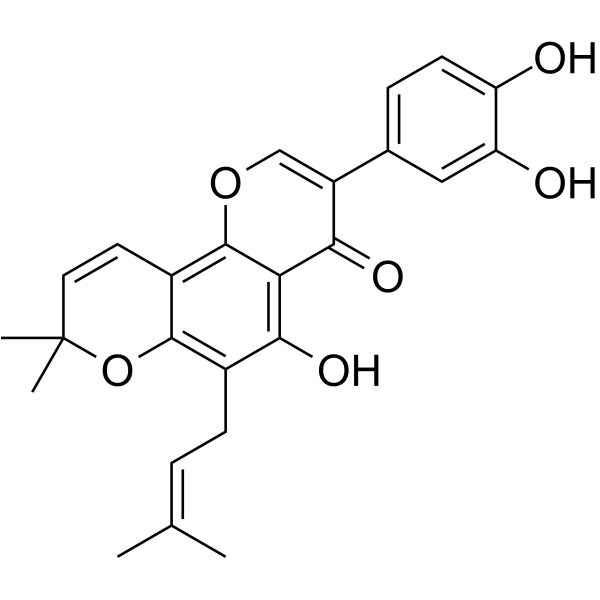Home
Products
Pomiferin



| Product Name | Pomiferin |
| Price: | Inquiry |
| Catalog No.: | CN04524 |
| CAS No.: | 572-03-2 |
| Molecular Formula: | C25H24O6 |
| Molecular Weight: | 420.46 g/mol |
| Purity: | >=98% |
| Type of Compound: | Flavonoids |
| Physical Desc.: | Powder |
| Source: | The fruits of Citrus aurantium L. |
| Solvent: | Chloroform, Dichloromethane, Ethyl Acetate, DMSO, Acetone, etc. |
| SMILES: |
| Contact us | |
|---|---|
| First Name: | |
| Last Name: | |
| E-mail: | |
| Question: | |
| Description | Pomiferin, a flavonoid from the fruits of Maclura pomifera, acts as an potential inhibitor of HDAC, with an IC50 of 1.05 μM, and also potently inhibits mTOR (IC50, 6.2 µM). |
| Target | HDAC:1.05 μM (IC50) mTOR:6.2 μM (IC50) |
| In Vitro | Pomiferin is an potential inhibitor of HDAC, with an IC50 of 1.05 μM. Pomiferin shows cytotoxic effects on human tumor cell lines, with GI50s of 1.32 ± 0.02 μM (HCT-15 cells), 2.92 ± 0.09 μM (MDA-MB-231 cells), 3.18 ± 0.05 μM (ACHN cells), 3.34 ± 0.11 μM (LOX-IMVI cells), 3.95 ± 0.05 μM (PC-3 cells), 5.14 ± 0.06 μM (NCI-H23 cells), and 123 μM (Hepatocyte cells)[1]. Pomiferin is a highly specific mTOR inhibitor, with an IC50 of 6.2 µM. Pomiferin triacetate only affects two PI3Kα mutants, E542K and E545K. Pomiferin triacetate (0.3125-20 µM) stabilizes Pdcd4 from TPA-induced degradation in HEK293 cells. Pomiferin triacetate (20 µM) inhibits IGF-1-induced signaling downstream of Akt activation[2]. |
| In Vivo | Pomiferin (5, 10 and 20 mg/kg, p.o.) shows protective effects on the treatment of reperfusion injury. Pomiferin also increases SOD activities and total antioxidative capacity, and decreases malondialdehyde in rats[3]. |
| Cell Assay | Cell lines purchased from ATCC are maintained in Dulbecco’s modified Eagle’s media (DMEM) supplemented with 10% horse serum and 5% fetal bovine serum and incubated in a CO2 incubator (5%) at 37°C. Cells are serum-deprived by three washes of PBS and resuspended in DMEM. The suspended cells are plated on 96-well plates (1 × 104 cells/well) and treated with Pomiferin. After treatment for 21 h, MTT is added to the medium (0.5 mg/mL), and the mixture is incubated at 37°C for another 3 h. After discarding the medium, DMSO (100 mL) is then applied to the well to dissolve the formazan crystals, and the absorbances at 570 and 630 nm in each well are measured on a micro-ELISA reader[1]. |
| Animal Admin | Rats[3] Male Wistar SPF laboratory rats are used in the study. After 10 days of acclimation, 50 animals are randomised in 5 groups (n=10). One group is left intact. Four groups undergo laparotomy in general anaesthesia (2% Rometar (xylazine) 0.5 mL + Narkamon (ketamine) 10 mL, dose 0.5 mL solution /100 g of body mass). Ischaemia-reperfusion injury is induced by applying a vascular clamp on the left renal artery for 60 min with subsequent renal reperfusion. Each animal (including those of the intact group) is put into its own metabolic cage. For 15 days all the animals are bred in these cages. The doses of pomiferin are suspended in 2 mL of 0.5% Avicel solution (microcrystalline cellulose) and are administered starting with day 1 after operation. Three of four operated groups are medicated with Pomiferin-orally by gastric gavage once a day in different doses: 5 mg/kg, 10 mg/kg and 20 mg/kg. The placebo group is given 2 mL of 0.5% Avicel by the same route. On day 15, all the animals are exsanguinated in general anaesthesia (2% Rometar 0.5 mL + Narkamon 10 mL, dose 0.5 mL solution /100 g of the rat body mass) by blood collection from the left ventricle and the reperfused kidney tissue is employed for histopathological examination[3]. |
| Density | 1.314g/cm3 |
| Boiling Point | 673.5ºC at 760 mmHg |
| Flash Point | 233.3ºC |
| Exact Mass | 420.15700 |
| PSA | 100.13000 |
| LogP | 5.26970 |